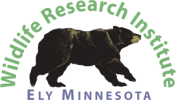Changes - UPDATE October 13, 2020
Much has changed in the last few days—especially the color. A beautiful golden yellow aspen has lost most of its leaves since the 10th. I tried to match the two pictures, but the branches angle upward more now without their leaves. The overlook shows that its the same everywhere.
 Aspen on 10-10 Aspen on 10-10 |
 Aspen 10-13-20 Aspen 10-13-20 |
The last of the red is still hanging on the branches of the scarce oaks. Seeing those leaves reminds me of a time back about 1990 when bears were showing me the importance of oaks to their reproduction, especially in years of berry crop failures. Females that knew their way to oak stands 20-40 miles outside their territories had the best reproductive success despite spending so much energy on the trip.  Northern Red Oak leafI wanted to know more about the oaks and was fortunate in being able to follow my whims. An odd sentence in my job description (http://bearstudy.org/website/images/stories/Documents/Lynn_Rogers_more_info.pdf) said “Supervision is characterized by a degree of confidence in and reliance on the researcher's productivity, competence, and judgment that there is an unusual level of support of his recommendations and his most novel and as yet seemingly fruitless investigations." Another sentence was nicer, saying “The supervisory relationship fully reflects recognition of the incumbent as a top technical authority in his field in the agency and as a distinguished and brilliant scientist." It took hard work to try to live up to that one. But on that fall day, I was able to schedule a U. S. Forest Service airplane to fly far and wide searching the ground for patches of red to map. Some patches were scattered trees. A five acre stand that the bears had shown me stood out strong.
Northern Red Oak leafI wanted to know more about the oaks and was fortunate in being able to follow my whims. An odd sentence in my job description (http://bearstudy.org/website/images/stories/Documents/Lynn_Rogers_more_info.pdf) said “Supervision is characterized by a degree of confidence in and reliance on the researcher's productivity, competence, and judgment that there is an unusual level of support of his recommendations and his most novel and as yet seemingly fruitless investigations." Another sentence was nicer, saying “The supervisory relationship fully reflects recognition of the incumbent as a top technical authority in his field in the agency and as a distinguished and brilliant scientist." It took hard work to try to live up to that one. But on that fall day, I was able to schedule a U. S. Forest Service airplane to fly far and wide searching the ground for patches of red to map. Some patches were scattered trees. A five acre stand that the bears had shown me stood out strong.  Deer grazesThen there was a mile-long stand on the south side of a narrow ridge—by far the biggest oak stand in my survey. A few days later, I walked it. I recorded bear sign and deer sign and was impressed with the number of ruffed grouse. I recorded every sign of wildlife I saw, including squirrels. I wanted the stand protected. Too many of these scarce but important trees were being cut for firewood. Hoping that someone in power would join my effort, I turned the data over to the DNR and The Nature Conservancy. The Conservancy went into action. It raised a huge amount of money and protected the oaks by buying the oak and the surrounding Palisade Valley and having it added to Tetegouche State Park. I have great respect for The Nature Conservancy to this day. A good memory.
Deer grazesThen there was a mile-long stand on the south side of a narrow ridge—by far the biggest oak stand in my survey. A few days later, I walked it. I recorded bear sign and deer sign and was impressed with the number of ruffed grouse. I recorded every sign of wildlife I saw, including squirrels. I wanted the stand protected. Too many of these scarce but important trees were being cut for firewood. Hoping that someone in power would join my effort, I turned the data over to the DNR and The Nature Conservancy. The Conservancy went into action. It raised a huge amount of money and protected the oaks by buying the oak and the surrounding Palisade Valley and having it added to Tetegouche State Park. I have great respect for The Nature Conservancy to this day. A good memory.
Out the window today, a brave (or very hungry) male red-breasted nuthatch won a prize in my mind. It repeatedly landed on the railing, cautiously approached a squirrel that had control of a pile of sunflower seed hearts, darted in to grab one, and flew off. I grabbed the camera and caught his next venture as the red squirrel looked on.
 Nuthatch grabs a seed Nuthatch grabs a seed |
 Success Success |
Also out that window, the head of an ancient dragon has appeared. It is sticking out its tongue and has the loose skin on the throat that some lizards have. I can’t identify the dragon, but the birds and squirrels are acting like it is not even there.
 Woody Dragon
Woody Dragon
In the yard, it’s deer now, not bears—at least by day. Ignoring leaves that cover the forest floor, the deer are coming to the biggest, best grassy spot I know, and it’s right outside the kitchen window. This deer could see me in the window but completely ignored me. Sometimes that feels good.
These events spiced up my day as I mostly sat at the computer.
Thank you for all you do.
Lynn Rogers, Biologist, Wildlife Research Institute and North American Bear Center

